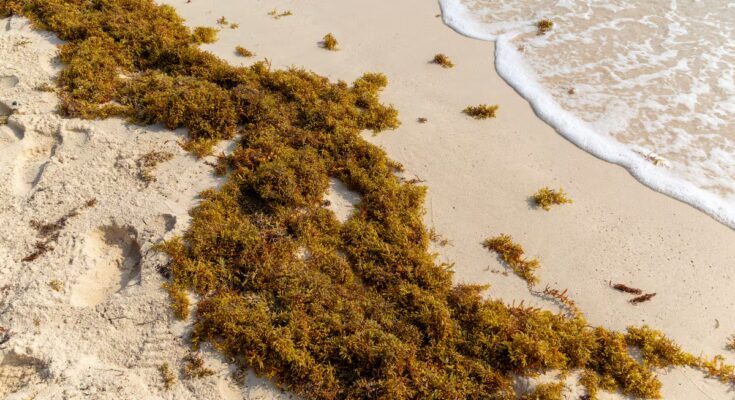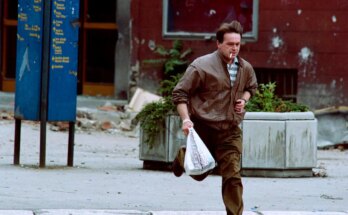The problem comes in the form of a soft, brown, slimy carpet on Granada’s fine white sand. About 15 years ago, almost no one in this small Caribbean island state had heard of sargassum, even though it has always been at the bottom of the sea in necessary and manageable quantities. When the beaches began to be invaded by mountains of this algae for several months of the year, the urgency was to collect this residue which drives tourists away, impoverishes local communities and causes damage to local ecosystems and health problems, due to the toxic fumes produced by its decomposition.
According to satellite images republished by scientific publications, as of early June this year, about 38 million tons of sargassum were floating toward the Caribbean coast, a record figure. Year after year, the volume of algae increases, reflecting the global climate imbalance. Increasing ocean temperatures and the amount of nutrients, mainly coming from human activities such as agriculture or untreated wastewater, have largely caused this massive proliferation.
“But states like Grenada don’t cause any of this: we don’t contribute to rising temperatures nor are we responsible for the agricultural waste that generates this pollution,” says Jane Nurse, a consultant working for the local government to develop a plan to collect and reuse sargassum.
For about five years, the challenge of the authorities in this tiny country of 110,000 inhabitants has been to transform the problem into an opportunity for businesses and a source of work. To do this they need innovative ideas, millions of euros and the participation of local communities.
“There was more and more seaweed, for more months of the year. Instead of throwing it back into the sea or letting it rot on beaches where no one wants to go anymore, let’s try to take advantage of it. We’re at a really important turning point,” Nurse says in an interview with this newspaper.
For a couple of years, even more innovative and unexpected cosmetics, fertilizers, fuels, building materials and other products have been taking shape. The authorities in Grenada have launched an appeal for concrete proposals on what to do with the sargassum and right now they have around 30 projects on the table. “In the coming months we will refine the selection and implement various financing mechanisms to implement these solutions,” explains Nurse.
The expert wants to believe that sargassum, indirectly, can spark some kind of awareness or action against climate change. “Because it’s there, it’s visible and concrete and annoying. It’s not about global warming in the abstract,” he says.
European money
During this process, not only the authorities and experts from Granada sat at the table. Since 2023, the European Union’s Global Gateway investment initiative has brought together local governments, private capital, academics and entrepreneurs in several sargassum-affected states to find sustainable and viable solutions in seaweed harvesting, processing and sales, and secure the funding and technical knowledge needed to realize these ideas. “Nobody brought everyone together to find a solution,” a European source present at these meetings tells EL PAÍS.
The European initiative focused above all on small states like Granada, which need more support for seaweed harvesting because unlike larger countries there are no large hotels that can finance it, as happens for example in Mexico.
“In 2023, the first question we asked our partners was whether they could have fresh sargassum. Because there are companies that want it directly from the sea and these small states do not have the capacity to carry out this ocean harvest and simply clean it up when it reaches the beaches,” explain the Brussels sources.
We must collect it before it reaches the beach because the danger it poses is real. For example, sargassum rotting in sand can affect fetal development and even affect asthma patients.
Jane Nurse, consultant to the government of Grenada
domino effect
The third EU-Caribbean meeting on sargassum was held in Brussels in October and Grenada, the Dominican Republic and Mexico committed to harvesting at least 660,000 tonnes of sargassum between 2026 and 2027. Of this total, Grenada committed to harvesting 10,000 tonnes, Mexico 500,000 and the Dominican Republic 150,000.
The methods for collecting sargassum, on the beach or in the sea, preserving it and processing it will depend on the use to which it is intended. “That’s why we ask for concrete proposals for each of these steps. Tell us what you want to do and how and we can bring capital to support you, but we need to know how much it costs to start all this,” explains the European source.
“We need to harvest it before it reaches the beach because the danger it poses is real. For example, sargassum rotting in the sand can affect fetal development and even affect asthma patients,” Nurse says. “All of this is happening in conjunction with rising sea levels, meaning that in states like Grenada we have fewer ways to cushion the arrival of sargassum,” he adds.
Mari Granström, founder and president of the company Origin by Ocean, was one of the entrepreneurs present at the Brussels meeting on sargassum last October. This Finnish chemist left her job at a large multinational to create her own company, which is dedicated to the extraction of chemicals from sargassum in the Caribbean, convinced that the damage caused by algae can be rebalanced by the potential it has.
“Our plan is for our first biorefinery to start operating in 2027 in Finland and then open four more in the Caribbean,” he explained to this newspaper in an interview in Brussels.
In October they presented their first facial serum based on chemicals extracted from sargassum, marketed by a Finnish brand. The uses of the chemicals extracted by this company will also be sold to other companies who will use them in textile, hair and household products. “But in Europe we are very slow. We tend to talk about the problems and don’t see this big opportunity, because we don’t understand how to build these value chains,” laments Granström.
The goal is that by the next EU-Caribbean sargassum conference in 2026 in Mexico, the ability to harvest and sell the seaweed in places like Grenada will be a reality. Cooperation projects are expanding and in October Global Gateway has already launched similar cooperation processes with Saint Kitts and Nevis and Saint Martin, two small Caribbean states affected by the same problem. “There is a very positive domino effect,” celebrate European sources.
We want to bring our technology to the Caribbean and start biorefineries, but train the inhabitants of the area so that they can guide them and the income reaches the place where the sargassum comes from.
Mari Granström, President of Origin by Ocean
With local communities
In the case of Granada, the local authorities will choose the solutions and these will be co-financed. “Because it is impossible to attract investments from companies for projects like this right from the start. It is too risky”, add the Brussels sources.
The nurse draws three main lines in these proposed solutions: the first is for the agricultural sector in the form of fertilizers, biostimulants or compost. The second is the production of energy through pyrolysis, for example, and another is the production of cosmetics, through chemicals extracted from sargassum, such as alginate and fucoidan, just like Granström does. Granström emphasizes that in these processes it is very important that local communities “are not just the people who harvest sargassum for European companies”.
“That’s not what we want to build. We want to bring our technology to the Caribbean and start biorefineries, but train the locals so they can run them and the income reaches where the sargassum comes from,” he adds.
For this Finnish entrepreneur, it could be the way for small Caribbean states to “go from local to global”. “And at the same time, reduce their dependence on tourism revenue,” he concludes.



